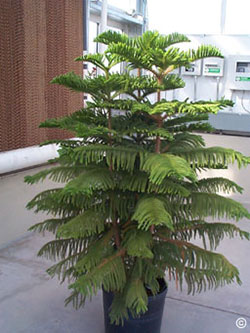
What is the Norfolk Island Pine?
Norfolk Island pine, Araucaria heterophylla, is a tropical evergreen tree that is adaptable to indoor gardening. In its native habitat, Norfolk Island which lies off the coast of Australia, it can grow up to 200 feet tall. As a houseplant it can reach a height of 20 feet with good care and ideal conditions but more often it grows to six feet tall or less.
Are Norfolk Island Pines native to Colorado?
The Norfolk Island pine is not a true pine and is not hardy in Colorado climates. The small trees are uniform in appearance and have branches that are parallel to the ground. They are often marketed as an alternative to a typical Christmas tree.
What is proper care for the Norfolk Island Pine?
Norfolk Island pines need at least two hours of bright, indirect sunlight daily to maintain their bright green foliage color. To ensure symmetrical, upright growth, rotate the plant weekly to keep it from permanently bending toward the light source. Temperatures of 60-72°F during the day and slightly cooler at night are optimum.
How much water does this tree need?
These houseplants require consistent moisture and high humidity. When the top inch of soil is dry to the touch, water thoroughly allowing excess water to drain out of the container. Discard the excess; to avoid root rot do not let the plant sit in water. The plant will require a bit less water in the winter months. In our dry Colorado climate, supplying adequate humidity for this plant is a challenge. Norfolk Island pines prefer an environment with about 50 percent humidity. Clustering plants, setting the growing container on a saucer filled with gravel and water or using a humidifier are a few options to increase the relative humidity around houseplants.
When should the Norfolk Island Pine be transplanted?
Only feed or transplant Araucaria when they are actively growing (March through September). To supply nutrients any standard soluble fertilizer formulated for houseplants will do. Araucaria are slow growers and only need to be transplanted when they show signs of being root bound or have roots growing out the base of the container.
What does browning of the needles mean?
Excessive browning of needles can be a sign of too little humidity, too little or too much water, or drafts from a furnace, air conditioner or outside door.



